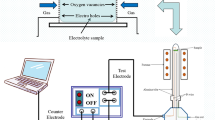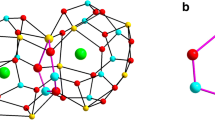Abstract
To understand electrochemical properties of the rare earth-doped CaZrO3 system in more detail, a solid-state electrolyte Er-doped CaZrO3 was successfully prepared using solid-state reaction method at the temperatures of 1673 K and 1823 K for 10 h. The microstructures and electrochemical properties of these materials were systemically investigated. The results from structural analysis showed that the electrolyte has a pure perovskite phase structure. According to the H/D isotope effect, protons were determined as the dominant charge carriers in hydrogen atmosphere between 773 and 1273 K. The electrochemical impedance spectroscopy test showed that ionic electrical conductivities are approximately 1.86 × 10−8 ~ 2.93 × 10−4 S/cm at 773 ~ 1273 K, and ionic conductance activation energy (Ea) is in the range of 0.823–1.416 eV, Furthermore, ionic electrical conductivity decreases with increasing Er2O3 doping amount, which is completely different from that of In2O3 or other dopant-doped CaZrO3. The abnormal phenomenon is associated with the defect association introduced by incorporation of Er2O3 into CaZrO3 lattice on the basis of the DFT calculation.












Similar content being viewed by others
References
Taahashi T, Iwahara H (1980) Protonic conduction in perovskite type oxide solid solutions. Rev Chim Miner 4:243–253
Iwahara H, Esaka T, Uchida H, Maeda N (1981) Proton conduction in sintered oxides and its application to steam electrolysis for hydrogen production. Solid State Ionics 3:359–363
Iwahara H, Uchida H, Ogaki OK, K, (1988) Proton conduction in sintered oxides based on BaCeO3. J Electrochem Soc 135:529–533
Shimura T, Esaka K, Matsumoto H, Iwahara H (2002) Protonic conduction in Rh-doped AZrO3 (A=Ba, Sr and Ca). Solid State Ionics 149:237–246
Hung IM, Chiang YJ, Jang SC, Lin JC, Hsi CS et al (2015) The proton conduction and hydrogen permeation characteristic of Sr(Ce0.6Zr0.4)0.85Y0.15O3−δ ceramic separation membrane. J Eur Ceram Soc 35:163–170
Katahira K, Kohchi Y, Shimura T, Iwahara H (2000) Protonic conduction in Zr-substituted BaCeO3. Solid State Ionics 138:91–98
Azad AK, Irvine JT (2018) High density and low temperature sintered proton conductor BaCe0.5Zr0.35Sc0.1ZnO3-α. Solid State Ionics 179:678–682
Yajima T, Kazeoka H, Yogo T, Iwahara H (1991) Proton conduction in sintered oxides based on CaZrO3. Solid State Ionics 47:271–275
Xu X, Wang H, Ma J, Liu W, Wang X, Marco F, Lei B (2019) Impressive performance of proton-conducting solid oxide fuel cells using a first-generation cathode with tailored cations. Journal of Materials Chemistry A 32:18792–18798
Marnellos G, Stoukides M (1998) Ammonia synthesis at atmospheric pressure. Science 282:98–100
Li J, Wang C, Wang X, Lei B (2020) Sintering aids for proton-conducting oxides–A double-edged sword? A mini review Electrochemistry Communications 112:106672–106675
Kobayashi K, Yamaguchi S, Iguchi Y (1998) Electrical transport properties of calcium zirconate at high temperature. Solid State Ionics 108:355–362
Xu X, Wang H, Marco F, Wang X, Lei B, Enrico T (2019) Tailoring cations in a perovskite cathode for proton-conducting solid oxide fuel cells with high performance. Journal of Materials Chemistry A 36:20624–20632
Kurita N, Fukatsu N, Ohashi T, Miyamoto S, Sato F, Nakai H, Irie K (1996) The measurement of hydrogen activities in molten copper using an oxide protonic conductor. Metall Mater Trans B 27:929–935
Ma J, Tao Z, Kou H, Marco F, Lei B (2020) Evaluating the effect of Pr-doping on the performance of strontium-doped lanthanum ferrite cathodes for protonic SOFCs. Ceram Int 46:4000–4005
Iwahara H, Asakura Y, Katahira K, Tanaka M (2004) Prospect of hydrogen technology using proton-conducting ceramics. Solid State Ionics 168:299–310
Lei B, Shafi S, Husni D, Enrico T (2018) Tailoring the cathode-electrolyte interface with nanoparticles for boosting the solid oxide fuel cell performance of chemically stable proton-conducting electrolytes. Small 32:1801231–1801239
Yajima T, Iwahara H, Koide K, Yamamoto K (1991) CaZrO3-type hydrogen and steam sensors: trial fabrication and their characteristics. Sensors Actuators B 5:145–147
Iwahara H (1996) Proton conducting ceramics and their applications. Solid State Ionics 86:9–15
Bao JX, Wang WW, Ruan F, Zhou F (2016) Electrochemical properties of CaZrO3–based solid electrolyte. J Asian Ceramic Soc 7:796–781
Bao J, Ohno H, Kurita N, Okuyama Y, Fukatsu N (2011) Proton conduction in Al-doped CaZrO3. Electrochim Acta 56:1062–1068
Bao J, Ohno H, Okuyama Y, Fukatsu N, Kurita N (2012) Electromotive force of the high-temperature concentration cell using Al-doped CaZrO3 as the electrolyte. Mater Trans 4:752–759
Bao J, Okuyama Y, Shi Z, Fukatsu N, Kurita N (2012) Properties of electrical conductivity in Y-doped CaZrO3.Mater Trans.5:973–979.
Bao J, Tian Z, Ruan F, Song XW, An S, l, Wang W W, Zhou F, Xie M, Chen X, Zhang, Y H, (2019) Research on the proton conduction and electrochemical properties of CaZr0.98−xIn0.02AlxO3−α. Ionics 25:2745–2753
Tian Z, Ruan F, Song BJ, X W, An S L, Wu R M, Jing Q, Lv H D, Zhou F, Xie M, (2019) Preparation and Electrochemical Properties of CaZr1-xScxO3-α. J Electrochem Soc 166:441–448
Zheng H, Reaney I, Gyorgyfalva G (2004) Raman spectroscopy of CaTiO3-based perovskite solid solutions. J Materials Res 19(02):488–495
Oliveira M, Gracia L, Assis M (2017) Mechanism of photoluminescence in intrinsically disordered CaZrO3 crystals: first principles modeling of the excited electronic states. J Alloy Compd 722:981–995
Tarrida M, Larguem L, Madon M (2009) Structural investigations of (Ca, Sr)ZrO3 and Ca(Sn, Zr)O3 perovskite compounds. Phys Chem Miner 722:981–995
Giannici F, Shirpour M, Longo A, Martorana A, Merkle R, Maier J (2011) Long-range and short-range structure of proton-conducting Y:BaZrO3. Chem Mater 23:2994–3002
Vracar M, Kuzmin A, Merkle R, Purans J, Kotomin EA, Maier J, Mathon O (2007) Jahn-Teller distortion around Fe4+ in SrFexTi1-xO3-δ from x-ray absorption spectroscopy, x-ray diffraction, and vibrational spectroscopy. Phys Rev B: Condens Matter Mater Phys 76:17410701–17410712
Gorbova E, Maragou V, Medvedev D, Demin A, Tsiakaras P (2008) Investigation of the protonic conduction in Sm doped BaCeO3. J Power Sources 181:207–213
Ma G, Shimura T, Iwahara H (1998) Ionic conduction and nonstoichiometry in BaxCe0.90Y0.10O3−α[J]. Solid State Ionics 110:103–110
Ahmed I, Eriksson SG, Ahlberg E, Knee CS, Berastegui P, Johansson LG, Rundlöf H, Karlsson M, Matic A, Börjesson L, Engberg D (2015) Synthesis and structural characterization of perovskite type proton conducting BaZr1-xInxO3-δ (0.0≤x≤0.75). Solid State Ionics 177:1395–1403
Acknowledgements
Special thanks to Professor Guixiao Jia, one of our colleagues, who gave us a great help for DFT calculation in our work.
Funding
This work was supported by the National Science Foundation of China (Grant No. 51864038 and 51762036), the Young Talents of Science and Technology in Universities of Inner Mongolia Autonomous Region (Grant No. NJYT-19-A20), the Innovation Fund of Inner Mongolia University of Science and Technology (Grant No. 2017YQL01), the Natural Science Foundation of Inner Mongolia (2017BS0504), the Guide and Innovation Award Fund of Inner Mongolia Autonomous Region Science and Technology (Grant No. 2017CXYD-7), and the Scientific Research Fund of Higher Education in Inner Mongolia Autonomous Region (NJZY21381).
Author information
Authors and Affiliations
Corresponding authors
Additional information
Publisher's Note
Springer Nature remains neutral with regard to jurisdictional claims in published maps and institutional affiliations.
Rights and permissions
About this article
Cite this article
Ruan, F., Wu, R., Li, Y. et al. Electrochemical and microstructure properties of Er-doped CaZrO3 . Ionics 27, 3511–3520 (2021). https://doi.org/10.1007/s11581-021-04104-y
Received:
Revised:
Accepted:
Published:
Issue Date:
DOI: https://doi.org/10.1007/s11581-021-04104-y




